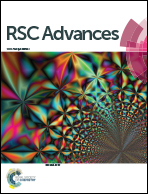A series of transition metal–organic frameworks: crystal structures, luminescence properties, and sensitizing for luminescent Ln(iii) ions in aqueous solution†
Abstract
A series of coordination polymers, namely, [Cd(DPDC)(BPP)·H2O]·H2O (1), Cd4(O-OBA)4(BPP)2 (2), [Zn2(DPDC)2(BTB)(H2O)2]·H2O (3), [Zn(O-OBA)(BPP)]·0.5H2O (4), [Zn(O-OBA)(BPP)]·H2O (5), Cu(DPDC)(BTB) (6) and [Co(O-OBA)(BTB)H2O]·0.5H2O (7) (DPDC = 2,2′-diphenyldicarboxylate, O-OBA = 2,2′-oxybis(benzoate), BPP = 1,3-di(4-pyridyl)propane, and BTB = 1,4-bis(1,2,4-triazol-1-yl)butane) were hydrothermally synthesized and structurally characterized. 1 forms a quadrilateral grid like network with {CdO4N3} polyhedra. 2 exhibits a 2D architecture containing four types of {Cd1O7}, {Cd3O7}, {Cd2O4N2} and {Cd4O4N2} polyhedra. 3 features a ladder like double chain that consists of Zn1–DPDC- and Zn2–DPDC-chains with {Zn1O4N} and {Zn2O4N} polyhedra. 4 possesses a helical 2D framework consisting of Zn2–O-OBA- and Zn1–BPP–Zn2–BPP-helical chains involving {Zn1O2N2} and {Zn2O2N2} tetrahedra. 5 consists of Zn–BPP–Zn–O-OBA-double helical chains with {ZnO2N2} tetrahedra. 6 has a (4, 4) 2D framework formed by Cu–DPDC- and Cu–BTB-chains involving {CuO4N2} octahedra. 7 consists of a 1D zigzag chain where the {CoO4N2} octahedra are bridged by BTB ligands, while the O-OBA behaves as a terminal ligand. Complex 4 shows solvent-dependent luminescence and can be used to detect nitrobenzene via the quenching effect. Moreover, complex 4 can notably sensitize luminescent lanthanide ions in aqueous solution to emit their characteristic emissions.


 Please wait while we load your content...
Please wait while we load your content...